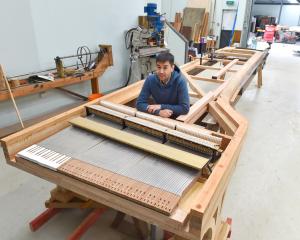
Scientists say this kind of research is helping put Dunedin and North Otago on the world map as leading areas for the study of ancient marine mammals, including whales. North Otago and South Canterbury are also being increasingly recognised as key places for the discovery of ancient marine fossils.
''Finishing my PhD feels fantastic - it is great to see it all come together after three years' work, and to realise that the effort has been worthwhile,'' Mr Marx said in an interview.
Mr Marx (28) will graduate from the university with a PhD in geology, at the first of two graduation ceremonies at the Regent Theatre, Dunedin, today.
He will be among about about 320 graduands, including in applied science, consumer and applied sciences, who will graduate at the 1pm ceremony.
His database focuses on the morphology - the form and structure - of baleen whales.
''The 4800-photograph data set is the biggest in the world on baleen whales, both fossil and alive,'' he said.
He plans to make the database available via the internet and hopes it will ''form an essential baseline for the further exploration of baleen whale diversity and evolutionary history''.
His research focused on the origins, interrelationships and past diversity of living and fossil baleen whales over the past 35 million years.
In terms of body shapes, whales were at their most diverse right after their origins, about 35 million years ago, implying a phase of rapid evolution early on in baleen whale history, he said.
His research was supervised by leading paleontologist Prof Ewan Fordyce, of the Otago geology department.
Thanks to Prof Fordyce, Dunedin and Otago University are now home to the world's largest single group of researchers - about seven - studying ancient marine mammal evolution.
''I think that Ewan's research, and that of his group, have certainly made Otago one of the most important places worldwide as far as research into whales and dolphins is concerned,'' Mr Marx said.
Prof Fordyce said Mr Marx had done an ''exceptional job'' with his research.
He had provided ''the most thorough account'' of baleen whale evolution that Prof Fordyce had seen. A key factor in the development of the Otago ancient marine mammal research had been Otago University's ''good support for PhD students''''It's really gone out of its way to attract good students,'' he said.
Born in Austria, Mr Marx completed a master of science honours degree in palaeontology and evolution at the University of Bristol, England, in 2009.
Advertisement













